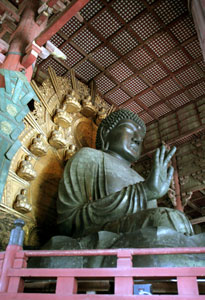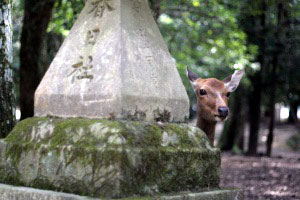nara
September 4, 2005


On Monday I went to Nara, which was, for a hundred years or so in about the 8th century, Japan’s first capital. I had a particularly excellent day because, going into the tourist information office in the morning to ask about that evening’s train times, I was offered a free guided tour by two university students who volunteer as English-speaking tour guides in order to practice their English. So instead of wandering around temples on my own, taking pictures and moving on semi-aimlessly, I spent the next six hours or so being shown round by two very enthusiastic and knowledgeable girls who actually seemed to think I was doing them a favour by letting them practice their English! I told them I would tell other people about their tours, and so if anyone reading this ever finds themselves in Nara, I’d highly, highly recommend dropping into the tourist information office and getting a free tour. They are available all year round (though the actual tour guides are different every day – they’re all students from nearby universities who volunteer a couple of times a month).
Nara is probably most famous for the Daibutsu – the giant bronze Buddha sculpture that is housed in the largest wooden building in the world (but which is, amazingly, only two-thirds the size of the original building). It’s also famous for the incredibly tame red deer that wander around the town, and which have been awarded National Treasure status by the Japanese government. I have photos of both Buddha and deer, but will have to wait until I get back to Okinawa before I can show you them.
Posted by mayee — September 11, 2005 at 1:31 am
the red deer looks really sweet… my! sculpting in bronze in that size in those days is a remarkable feat! wow.
Posted by lva — September 11, 2005 at 2:35 am
The deer were so tame! People feed them the whole time, and on top of that, they’re National Treasures anyway, so they’ve never needed to learn to be wary of humans.
According to the girls who showed me around, the Buddha was built in the 8th century in a time of great strife – the emperor’s idea was that building a vast buddha might help put an end to the famine and warfare that were affecting the country at the time. They told me that about 2 million people were involved in its construction! Although the hall around it has been destroyed by fire and rebuilt twice, the buddha is still more-or-less his original self, I think, although he’s onto (at least) his second head, because the original fell off in an earthquake. And one of his shoulders has been patched too. I suppose you have to expect a certain amount of wear and tear in 1200 years…